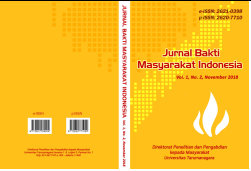PENINGKATAN REGULASI PERILAKU MELALUI COGNITIVE BEHAVIOR PLAY THERAPY PADA KELOMPOK ANAK DIDIK LEMBAGA PEMASYARAKATAN DI TANGERANG
Main Article Content
Abstract
Teenagers who violate the rules of criminal law are in the Lembaga Pemasyarakatan (Penitentiary). In a correctional institution for boys in Tangerang, adolescents undergo their prison terms and still get the opportunity to attend school or learn skills. In the interaction of adolescents in correctional institutions, they are often complained about behavior that is not according to rules such as theft, fighting or disturbing friends/ bullying. The inability of adolescents to control their behavior even though they are already in correctional institutions illustrates their difficulties in regulating behavior. Behavioral regulation is part of the human executive function to be able to direct behavior in a purpose so as to make the right decision. Behavioral regulation can be trained with psychological therapy using the game approach. Cognitive Behavioral Play Therapy applied to 10 adolescents in correctional institutions shows that there was a change in the value of behavioral regulation.
Article Details
This work is licensed under a Jurnal Bakti Masyarakat Indonesia https://creativecommons.org/licenses/by-nc-sa/4.0/
References
Archer, J. (2009). The nature of human aggression. International Journal of Law and
Psychiatry, 32, 202–208. doi:10.1016/j.ijlp.2009.04.001
Badamian, R., & Moghaddam, N. E. (2017). The effectiveness of cognitive-behavioral play
therapy on flexibility in aggressive children. Journal of Fundamentals of Mental Health, p.
-137.
Bailey, C.A. & Ostrov, J.M. (2008). Differentiating forms and functions of aggression in
emerging adults: Associations with hostile attribution biases and normative beliefs. Youth Adolescence, 37:713–722. DOI 10.1007/s10964-007-9211-5
Bratton, S., Ray, D., Rhine, T., & Jones, L. (2005). The efficacy of play therapy with children: A
meta-analytic review of the outcome research. Professional Psychology: Research and
Practice, 36(4), 376-390.
Carlo, G., Mestre, M.V., McGinley, M.M., Samper, P., Tur, A., & Sandman, D. (2012). The
interplay of emotional instability, empathy, and coping on prosocial and aggressive behaviors.
Personality and Individual Differences. 53, 675–680.
Denson, T.F., Capper, M.M., Oaten, M., Friese, M., & Schofield, T.P. (2011). Self-control
training decreases aggression in response to provocation in aggressive individuals. Journal of Research in Personality, 45: 252–256.
Fazio-Griffith, L.J., & Marino, R. (2017). A Cognitive-Behavioral Play Therapy (CBPT)
approach for adolescents' pro-social skill development in the school setting: In emerging
research in play therapy. Child Counseling, and Consultation. DOI: 10.4018/978-1-5225- 2224-9.ch008
Graham, A. (n.d.). Cognitive behavior play therapy. Retrieved from
http://www.annegraham.ca/what-is-play-therapy.html
Jones, C. (2002). Executive and social cognitive function in reactive proactive aggressive
young boys. Dissertation. Simon Fraser University.
Karismatika, I. (2014). Terapi kognitif perilaku untuk remaja dengan gangguan tingkah laku.
Jurnal Sains dan Praktik Psikologi, 2(3), 296-301.
Kemp, K., Thamotharan, S., Poindexter, B., Barker, D., Tolou-Shams, M., & Houck, C.D.
(2017). Emotion regulation as a predictor of juvenile arrest. Criminal Justice and
Behavior. DOI: doi.org/10.1177/0093854817695842
Kim, Y.J. (2017). Longitudinal relationship between Emotion regulation and aggressive
behavior: The moderating effect of caregiving. Dissertation. Submitted to the Graduate
Faculty of School of Social Work, University of Pittsburgh.
Knell, S. M., & Dasari, M. (2011). Cognitive-behavioral play therapy. In S. W. Russ & L. N.
Niec (Eds.) Play in clinical practice: Evidence-based approaches (pp. 236-263). New York,
NY, US: Guilford Press.
Koolen, S., Poorthuis, A., & Aken, M.A. G. (2012). Cognitive distortions and self-regulatory
personality traits associated with proactive and reactive aggression in early adolescence.
Cogn Ther Res. 36:776–787. DOI 10.1007/s10608-011-9407-6
Lowry (2016). What is behaviour regulation? And what does it have to do with language
development?. Hanen Centre. Retrieved online February 16, 2018: http://www.hanen.org/helpful-info/articles/what-is-behaviour-regulation--and-what-does-it-hav.aspx
Riyadi, E.I., Wiguna, T., & Irmansyah. (2009). Behavior rating inventory of executive
fnction version bahasa Indonesia (BRIEF-BI). Thesis. Psychiatry Department, Faculty of
Medical, Universitas Indonesia, Cipto Mangunkusumo Hospital, Jakarta.
Sistem Database Pemasyarakatan. (2011). Diunduh dari http://smslap.ditjenpas.go.id/public/grl/detail/monthly/upt/db5b9480-6bd1-1bd1-fbe3-313134333039
Soetikno, N. & Basaria, D. (2015). Subjective well-being dan regulasi diri remaja pelaku
tindak kekerasan: Studi pada anak pidana di Lembaga Pemasyarakatan Anak Pria –
Tangerang). Conference: Temu Ilmiah Nasional APSIFOR V, Universitas Dhyana Pura –
Bali.
Yuliyanto & Ernis, Y. (2016). Lembaga pembinaan khusus anak dalam perspektif sistem
peradilan pidana anak. Diunduh dari
http://sipkumham.balitbangham.go.id/assets/img/dokumenpenelitian/PTL20171109015102016_A20.pdf


